The Olive Market is estimated to be valued at USD 17.3 billion in 2025 and is projected to reach USD 27.5 billion by 2035, registering a compound annual growth rate (CAGR) of 4.7% over the forecast period.
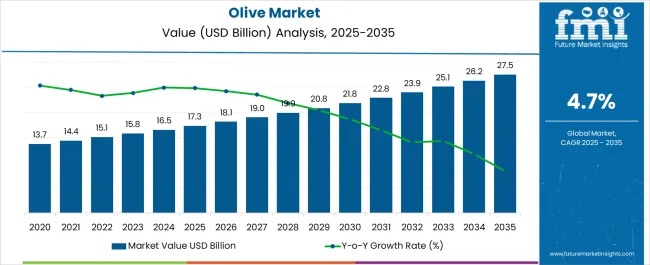
| Metric | Value |
|---|---|
| Olive Market Estimated Value in (2025 E) | USD 17.3 billion |
| Olive Market Forecast Value in (2035 F) | USD 27.5 billion |
| Forecast CAGR (2025 to 2035) | 4.7% |
The Olive market is witnessing robust growth, driven by the increasing global demand for health-oriented food products and natural ingredients across diverse consumer segments. Rising awareness regarding the nutritional benefits of olives and olive-based products, including antioxidant properties, cardiovascular support, and anti-inflammatory effects, is contributing to expanding adoption. The market is further supported by increasing use of olive oil in culinary applications, as well as in cosmetic and personal care products due to its moisturizing and antioxidant properties.
Growing consumer preference for organic and minimally processed food products has also strengthened demand. The expansion of retail distribution channels, including supermarkets, online marketplaces, and specialty stores, is enhancing product accessibility and visibility. Additionally, the promotion of Mediterranean diets and health-conscious lifestyles is influencing consumption patterns.
Investments in sustainable farming practices, quality control, and innovative processing techniques are driving product differentiation and consumer trust As demand for natural and nutrient-rich food ingredients continues to rise, the Olive market is expected to maintain sustained growth across food, personal care, and wellness industries.
The olive market is segmented by end use, product form, product type, distribution channel, and geographic regions. By end use, olive market is divided into Food Industry, Cosmetic And Personal Care Industry, Pharmaceuticals Industry, Food Service, and Household. In terms of product form, olive market is classified into Olive Oil and Raw Olive. Based on product type, olive market is segmented into Green Olive and Black Olive. By distribution channel, olive market is segmented into Indirect, Direct, Modern Trade, Specialty Stores, Online Stores, and Other Retail Stores. Regionally, the olive industry is classified into North America, Latin America, Western Europe, Eastern Europe, Balkan & Baltic Countries, Russia & Belarus, Central Asia, East Asia, South Asia & Pacific, and the Middle East & Africa.
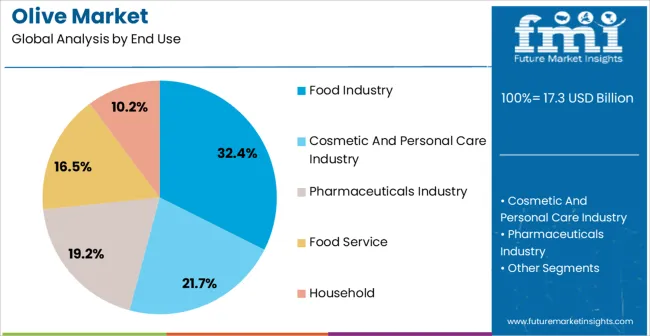
The food industry segment is projected to hold 32.4% of the Olive market revenue in 2025, establishing it as the leading end-use category. Growth is being driven by the increasing use of olives and olive-derived products in cooking, seasoning, dressings, and processed foods. Olive oil, in particular, is preferred for its flavor, nutritional profile, and health benefits, while green and black olives are increasingly incorporated into packaged foods, ready-to-eat meals, and gourmet products.
Consumers are gravitating toward natural, minimally processed ingredients, boosting demand for high-quality olives. The segment benefits from rising awareness regarding the Mediterranean diet and its association with cardiovascular health, longevity, and overall wellness. Retail expansion, including supermarkets, specialty stores, and e-commerce platforms, is improving product accessibility.
In addition, innovations in packaging, organic certification, and cold-press extraction techniques are enhancing product appeal and shelf life As the food industry continues to focus on healthier, functional, and premium ingredients, the olive segment is expected to retain its market leadership and drive overall growth.
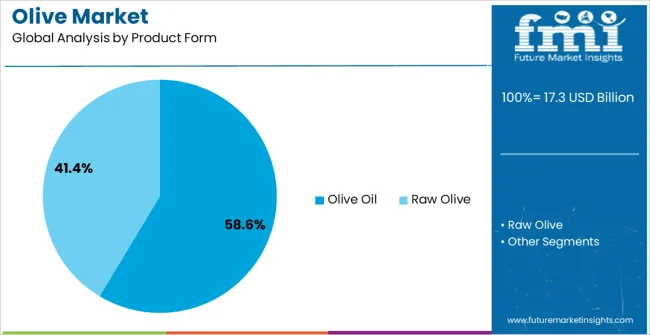
The olive oil segment is anticipated to account for 58.6% of the market revenue in 2025, making it the leading product form. Its dominance is being reinforced by the widespread culinary, health, and cosmetic applications of olive oil. Consumers increasingly prefer olive oil for cooking, salad dressings, and nutritional supplementation due to its beneficial fatty acids, antioxidants, and natural flavors.
Cold-pressed and extra virgin varieties are gaining traction as premium products in both domestic and international markets. The segment benefits from growing awareness regarding heart-healthy diets, cholesterol management, and anti-inflammatory properties. Retail availability in supermarkets, health stores, and online channels further accelerates adoption.
Olive oil is also leveraged in skincare, hair care, and wellness applications, creating cross-industry demand Production innovations, such as sustainable harvesting, high-quality extraction, and enriched formulations, have strengthened product reliability and consumer trust As health consciousness and premium product consumption continue to rise globally, olive oil is expected to maintain its leadership, driving overall market growth and innovation.
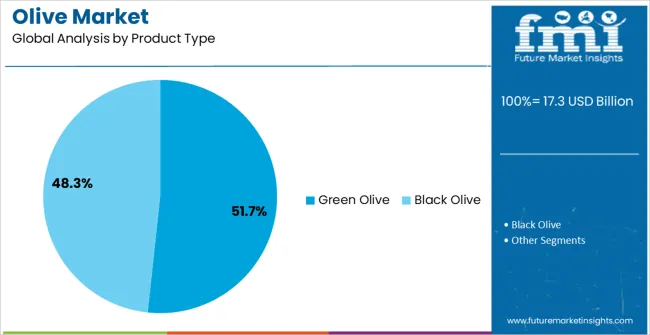
The green olive segment is projected to hold 51.7% of the market revenue in 2025, establishing it as the leading product type. Its market leadership is supported by consumer preference for fresh, minimally processed, and nutrient-rich products that offer flavor versatility and health benefits. Green olives are widely incorporated into salads, appetizers, condiments, and gourmet culinary creations due to their mild taste, texture, and nutritional profile.
Growing awareness of the Mediterranean diet, coupled with a focus on natural antioxidants, vitamins, and healthy fats, is reinforcing demand. The segment benefits from advancements in post-harvest processing, packaging, and storage technologies that preserve freshness, extend shelf life, and maintain sensory qualities. Retail expansion through supermarkets, specialty stores, and online platforms further improves accessibility and visibility.
Increasing adoption in health-conscious diets, premium foods, and functional culinary products is expected to strengthen market penetration As global consumer focus shifts toward healthier, flavorful, and natural ingredients, the green olive segment is likely to maintain its leading position, driving overall revenue growth in the Olive market.
Olive is a fruit obtained from olive tree found in Mediterranean Basin and is one of the most extensively cultivated crop. Olive pits is also obtained from this tree. Olive (also called table olive), which is a prime raw material used to manufacture a well-known product called olive oil.
Manufacturing of olive oil involves few byproducts such as crude olive cake, exhaustive olive cake, partly destined olive cake, olive pulp and vegetation waters. One unique product obtained from production of olive oil is biological fuel. T
hough olives belongs to the category of fruits but they are not consumed directly by a lot of public because of its bitter taste. Olives are also used for culinary uses and can’t be eaten directly after it gets mature, as it requires some processing after it falls from the tree.
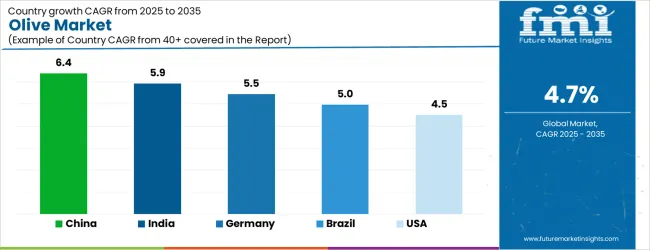
| Country | CAGR |
|---|---|
| China | 6.4% |
| India | 5.9% |
| Germany | 5.5% |
| Brazil | 5.0% |
| USA | 4.5% |
| UK | 4.0% |
| Japan | 3.6% |
The Olive Market is expected to register a CAGR of 4.7% during the forecast period, exhibiting varied country level momentum. China leads with the highest CAGR of 6.4%, followed by India at 5.9%. Developed markets such as Germany, France, and the UK continue to expand steadily, while the USA is likely to grow at consistent rates. Japan posts the lowest CAGR at 3.6%, yet still underscores a broadly positive trajectory for the global Olive Market. In 2024, Germany held a dominant revenue in the Western Europe market and is expected to grow with a CAGR of 5.5%. The USA Olive Market is estimated to be valued at USD 5.9 billion in 2025 and is anticipated to reach a valuation of USD 5.9 billion by 2035. Sales are projected to rise at a CAGR of 0.0% over the forecast period between 2025 and 2035. While Japan and South Korea markets are estimated to be valued at USD 917.8 million and USD 552.0 million respectively in 2025.
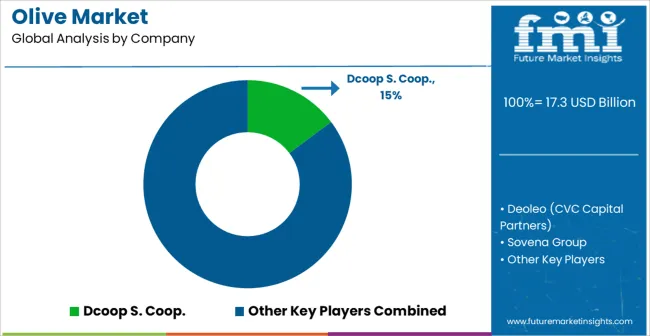
| Item | Value |
|---|---|
| Quantitative Units | USD 17.3 Billion |
| End Use | Food Industry, Cosmetic And Personal Care Industry, Pharmaceuticals Industry, Food Service, and Household |
| Product Form | Olive Oil and Raw Olive |
| Product Type | Green Olive and Black Olive |
| Distribution Channel | Indirect, Direct, Modern Trade, Specialty Stores, Online Stores, and Other Retail Stores |
| Regions Covered | North America, Europe, Asia-Pacific, Latin America, Middle East & Africa |
| Country Covered | United States, Canada, Germany, France, United Kingdom, China, Japan, India, Brazil, South Africa |
| Key Companies Profiled | Dcoop S. Coop., Deoleo (CVC Capital Partners), Sovena Group, Borges Agricultural & Industrial Nuts, S.A. (Borges International Group), California Olive Ranch. Inc, Colavita S.p.A., Almazaras de la Subbetica, Aceites Maeva, Olivar de Segura, Ybarra, Migasa, and Filippo Berio (GRUPPO SALOV) |
The global olive market is estimated to be valued at USD 17.3 billion in 2025.
The market size for the olive market is projected to reach USD 27.5 billion by 2035.
The olive market is expected to grow at a 4.7% CAGR between 2025 and 2035.
The key product types in olive market are food industry, cosmetic and personal care industry, pharmaceuticals industry, food service and household.
In terms of product form, olive oil segment to command 58.6% share in the olive market in 2025.






Our Research Products

The "Full Research Suite" delivers actionable market intel, deep dives on markets or technologies, so clients act faster, cut risk, and unlock growth.

The Leaderboard benchmarks and ranks top vendors, classifying them as Established Leaders, Leading Challengers, or Disruptors & Challengers.

Locates where complements amplify value and substitutes erode it, forecasting net impact by horizon

We deliver granular, decision-grade intel: market sizing, 5-year forecasts, pricing, adoption, usage, revenue, and operational KPIs—plus competitor tracking, regulation, and value chains—across 60 countries broadly.

Spot the shifts before they hit your P&L. We track inflection points, adoption curves, pricing moves, and ecosystem plays to show where demand is heading, why it is changing, and what to do next across high-growth markets and disruptive tech

Real-time reads of user behavior. We track shifting priorities, perceptions of today’s and next-gen services, and provider experience, then pace how fast tech moves from trial to adoption, blending buyer, consumer, and channel inputs with social signals (#WhySwitch, #UX).

Partner with our analyst team to build a custom report designed around your business priorities. From analysing market trends to assessing competitors or crafting bespoke datasets, we tailor insights to your needs.
Supplier Intelligence
Discovery & Profiling
Capacity & Footprint
Performance & Risk
Compliance & Governance
Commercial Readiness
Who Supplies Whom
Scorecards & Shortlists
Playbooks & Docs
Category Intelligence
Definition & Scope
Demand & Use Cases
Cost Drivers
Market Structure
Supply Chain Map
Trade & Policy
Operating Norms
Deliverables
Buyer Intelligence
Account Basics
Spend & Scope
Procurement Model
Vendor Requirements
Terms & Policies
Entry Strategy
Pain Points & Triggers
Outputs
Pricing Analysis
Benchmarks
Trends
Should-Cost
Indexation
Landed Cost
Commercial Terms
Deliverables
Brand Analysis
Positioning & Value Prop
Share & Presence
Customer Evidence
Go-to-Market
Digital & Reputation
Compliance & Trust
KPIs & Gaps
Outputs
Full Research Suite comprises of:
Market outlook & trends analysis
Interviews & case studies
Strategic recommendations
Vendor profiles & capabilities analysis
5-year forecasts
8 regions and 60+ country-level data splits
Market segment data splits
12 months of continuous data updates
DELIVERED AS:
PDF EXCEL ONLINE
Olive Oil Market Size and Share Forecast Outlook 2025 to 2035
Olive and Olive Derivatives Market – Growth, Demand & Industry Insights
Olive Leaf Extract Market

Thank you!
You will receive an email from our Business Development Manager. Please be sure to check your SPAM/JUNK folder too.
Chat With
MaRIA